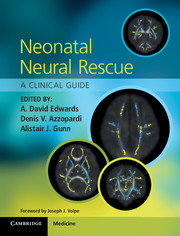Book contents
- Frontmatter
- Contents
- List of contributors
- Foreword
- Section 1 Scientific background
- Section 2 Clinical neural rescue
- 6 Challenges for parents and clinicians discussing neuroprotective treatments
- 7 The pharmacology of hypothermia
- 8 Selection of infants for hypothermic neural rescue
- 9 Hypothermia during patient transport
- 10 Whole body cooling for therapeutic hypothermia
- 11 Selective head cooling
- 12 Hypothermic neural rescue for neonatal encephalopathy in mid- and low-resource settings
- 13 Cerebral function monitoring and EEG
- 14 Magnetic resonance imaging in hypoxic–ischaemic encephalopathy and the effects of hypothermia
- 15 Novel uses of hypothermia
- 16 Neurological follow-up of infants treated with hypothermia
- 17 Registry surveillance after neuroprotective treatment
- Section 3 The future
- Index
- References
7 - The pharmacology of hypothermia
from Section 2 - Clinical neural rescue
Published online by Cambridge University Press: 05 March 2013
- Frontmatter
- Contents
- List of contributors
- Foreword
- Section 1 Scientific background
- Section 2 Clinical neural rescue
- 6 Challenges for parents and clinicians discussing neuroprotective treatments
- 7 The pharmacology of hypothermia
- 8 Selection of infants for hypothermic neural rescue
- 9 Hypothermia during patient transport
- 10 Whole body cooling for therapeutic hypothermia
- 11 Selective head cooling
- 12 Hypothermic neural rescue for neonatal encephalopathy in mid- and low-resource settings
- 13 Cerebral function monitoring and EEG
- 14 Magnetic resonance imaging in hypoxic–ischaemic encephalopathy and the effects of hypothermia
- 15 Novel uses of hypothermia
- 16 Neurological follow-up of infants treated with hypothermia
- 17 Registry surveillance after neuroprotective treatment
- Section 3 The future
- Index
- References
Summary
Introduction
The possibility that hypothermia might prevent or lessen asphyxial brain injury is a “dream revisited”, first proposed more than 300 years ago by Floyer [1]. Early experimental studies, mainly in precocial animals such as rat pups and kittens, demonstrated that hypothermia during severe hypoxia/asphyxia greatly extended the “time to last gasp” and improved functional recovery [2]. These encouraging data led to uncontrolled studies in the 1950s and 1960s, in which infants who were not breathing spontaneously at 5 minutes after birth were immersed in cold water until respiration resumed and then allowed to slowly spontaneously rewarm [3]. Outcomes after cooling at birth were reported to be better than for historical controls. Although these studies preceded the development of active resuscitation, immersion cooling was able to be combined with positive pressure resuscitation [4]. These provocative studies were not followed up because of the recognition that mild hypothermia was associated with increased oxygen requirements and greater mortality in premature newborns (<1500 g) [5] and disappointing outcomes from a small cohort of children resuscitated from near-drowning [6].
In retrospect, a key conceptual limitation of the early preclinical studies was that they tested cooling during severe hypoxia [2], in contrast with the clinical setting where cooling was induced many hours after resuscitation [7]. This chapter reviews the key empirical developments that helped to delineate the experimental parameters that determine whether post-resuscitation cooling is or is not successful and then relates the parameters to potential mechanisms of hypothermic neuroprotection.
- Type
- Chapter
- Information
- Neonatal Neural RescueA Clinical Guide, pp. 73 - 84Publisher: Cambridge University PressPrint publication year: 2013
References
- 4
- Cited by



